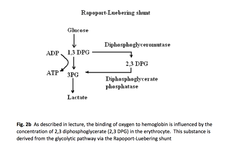Hematology Chapter 9 – Flashcards
Unlock all answers in this set
Unlock answersquestion
Hereditary nonspherocytic hemolytic anemia
answer
Hereditary deficiency of nearly every enzyme involved in glycolysis. A common result of these deficiencies is shortened RBC survival, known as __?
question
Cation pumps
answer
Transmembranous cation gradient concentration proteins
question
-maintenance of intracellular cationic electrochemical gradients -maintenance of membrane phospholipid -maintenance of skeletal protein plasticity -maintenance of functional ferrous Hb -protection of cell proteins from oxidative denaturation -initiation and maintenance of glycolysis -synthesis of glutathione -mediation of nucleotide salvage reactions
answer
Erythrocyte metabolic processes requiring energy:
question
-O2 exchange -O2 binding to heme iron
answer
Erythrocyte metabolic process not requiring energy:
question
facilitated membrane transport system
answer
How does plasma glucose enter the RBC?
question
involves glucose phosphorylation, isomerization, and diphosphorylation --> fructose 1,6-biphosphate (substrate for aldolase cleavage) --> glyceraldehyde 3-phosphate (G3P)
answer
Explain 1st phase of glucose catabolism.
question
G3P --> 3-phophoglycerate (3-PG) --> 1,3-biphosphoglycerate (1,3-BPG) --[dephosphorylated by phosphoglycerate kinase]--> ATP + 3-PG
answer
Explain 2nd phase of glucose catabolism.
question
3-PG --[isomerized by phophoglyceromutase]--> 2-phosphoglycerate (2-PG) --[enolase]--> phosphoenolpyruvate (PEP) --[pyruvate kinase]--> ATP + pyruvate
answer
Explain 3rd phase of anaerobic glucose catabolism.
question
Hexose Monophosphate
answer
detoxifies accumulated peroxide, oxidizes heme iron, proteins, and lipids.
question
G6PD activity
answer
able to detoxify oxidative compounds and safeguard Hb, sulfhydryl-containing enzymes, and membrane thiols, allowing normally functioning RBCs to carry enormous quanitities of O2 safely
question
G6PD deficiency
answer
Most common human RBC enzyme deficiency worldwide resulting in hereditary nonspherocytic anemia.
question
Methemoglobin
answer
Hemoglobin with iron in the ferric state.
question
methemoglobin reductase [cytochrome b5 reductase (cytob5r)]
answer
-Reduction of methemoglobin by NADPH is more efficient in the presence of ___? *acts as an intermediate electron carrier
question
Rapoport-Luebering Pathway

answer
-generates 2,3-biphosphoglycerate -cell is put in ATP deficit by this diversion
question
2,3-biphosphoglycerate (2,3-BPG)
answer
-regulates O2 delivery to tissues by essentially competing with O2 for Hb -when it binds, O2 is released, which enhances delivery of O2 to the tissues
question
RBC deformability
answer
-property of a RBC to stretch undamaged up to 2.5 times their resting diameter as they pass through narrow capillaries and through splenic pores 2 um in diamter
question
1. RBC geometry 2. Cytoplasmic (Hb) viscosity 3. Membrane elasticity (pliancy)
answer
RBC properties that contributes to deformability:
question
Cholesterol
answer
-confers tensile strength to the lipid bilayer
question
Acanthocytosis
answer
-results from deficiency in membrane enzymes that maintain the cholesterol concentration by regularly exchanging membrane and plasma cholesterol
question
Target cell
answer
-In liver disease with low bile salt concentration, membrane cholesterol concentration becomes reduced. It results in this RBC appearance *plasma bile salt concentration affects cholesterol exchange
question
Glycocalyx
answer
A layer of carbs whose net negative charge prevents microbial attack and protects the RBC from mechanical damage caused by adhesion to neighbouring RBCs or to the endothelium.
question
Glycolipids
answer
-make up 5% of external half of RBC membrane -associate in clumps and support carb side chains that extend into plasma to form glycocalyx -antigens of ABO/Rh and Lewis blood group systems are made up of this
question
-support surface carbs -serve as transport (disruption changes osmotic tension=rise in viscosity and loss of deforambility) and adhesion sites (change permits RBC to adhere to each other and vessels) and signaling receptors (signal tarnsduction) -skeletal anchorages (i.e. ankyrin) provide RBC membrane structural integrity
answer
What are some functions of transmembranous proteins?
question
- a-spectrin - B-spectrin
answer
What are the principal skeletal proteins?
question
Spherocytes
answer
-Too few vertical anchorages to maintain stability -The lipid membrane peels off in small blebs called vesicles, whereas the cytoplasmic volume remains intact. It generates this form of RBC
question
Elliptocytes
answer
-membrane fails to rebound from deformation, and RBCs progressively elongate to form this RBC -causes a mild to severe hemolytic anemia
question
Aquaporin 1
answer
a transmembranous protein that forms pores or channels whose surface charge create inward flow of water in response to internal osmotic changes
question
Colloid Osmotic Hemolysis
answer
Pump machanism damage permits the influx of Na+, with water following osmotically. The cell swells, becomes spheroid, and eventually ruptures, spilling Hb. What is this phenomenon called?



